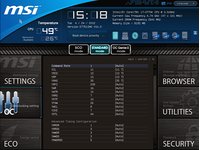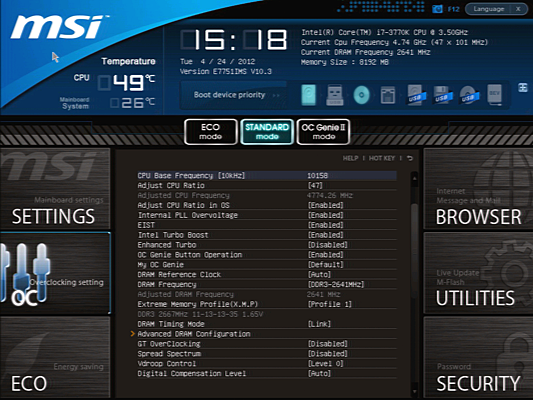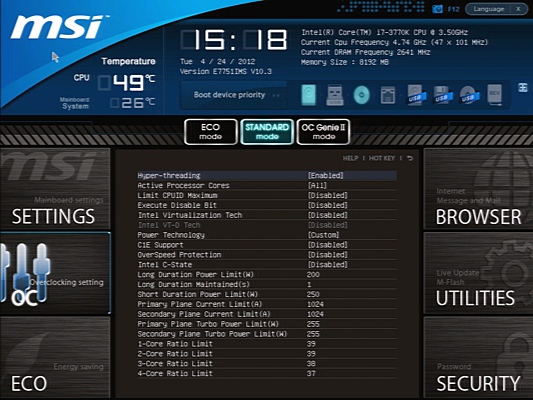Six $160-220 Z77 Motherboards, Benchmarked And Reviewed
Combining the newest features with moderate expandability, Intel’s mainstream platforms provide high value to most gaming and overclocking enthusiasts. We compare six examples with Z77 Express to find the best features, overclocking, and efficiency.
Z77A-GD65 Firmware
MSI crowds its overclocking controls into a small portion of the screen’s center. If you can get over that minor annoyance, you'll find a good selection and range of settings. The Z77A-GD65’s OC menu opens up to base clock, CPU multiplier, and DRAM frequency settings on the first page.
The Z77A-GD65 pushes an astounding 4.77 GHz using a mere 1.30 V on a Core i7-3770K processor. Similarly remarkable is that we got there using air cooling using nothing more than a single-fan Thermalright MUX-120 heat sink.
More voltage controls are found further down the menu, followed by several submenu options. DDR3-2709 was the highest stable two-DIMM memory speed for G.Skill's DDR3-2666 kit using MSI’s Z77A-GD65 at XMP values.
The Z77A-GD65’s CPU Features submenu includes power limits and per-core multipliers. Setting a higher base multiplier on the main menu allows the board to ignore per-core multipliers.


Primary, secondary and tertiary timings are all available within the Advanced Timing submenu. This menu is enabled for both channels by choosing Link from the main menu’s DRAM timing mode, and can be expanded to per-channel timings by choosing Unlink from the main menu.
Get Tom's Hardware's best news and in-depth reviews, straight to your inbox.
-
yougotjaked There's a typo on the last page. It says X77H2-A2X instead of Z77H2-A2X :P It's on the second to last paragraph...Reply -
HMSvictory I am surprised that you guys did not include the Asus z77-VReply
http://www.newegg.com/Product/Product.aspx?Item=N82E16813131820 -
confish21 One thing i was looking for was the part about asrock not having true "digital" PWM and going with an analog PWM. Does this really matter?Reply -
Crashman TekN9NeGreat review! At the end of day, it comes down to brand loyalty.I don't think the article stated anything like that. It comes down to the features you want and the cards you plan to use. In the MSI vs ASRock debate, it's x8-x4-x4 with all three slots in PCIe 3.0 mode, or x8-x8-x4 with x4 in PCIe 2.0 mode, and you're definitely wiser to pick between them based on WHAT you plan to use in the third slot.simone saysdo you mean nvidia and intel gets news during weekends not only news but featured articles?It's Monday here, and editorial has very little contact with news.HMSvictoryI am surprised that you guys did not include the Asus z77-Vhttp://www.newegg.com/Product/Prod 6813131820Tom's Hardware didn't "include" anything in the review. A couple boards were excluded based on price, and everything else was let in. The P8Z77-V Pro was the cheapest board Asus sent.rickrentswhy not with Pci-e 3.0?Editor had no PCIe 3.0 cards. And the reason he didn't get one yet is because it didn't matter. The only thing that really mattered in a single-GPU MOTHERBOARD comparison was to use the same card on all platforms.confish21One thing i was looking for was the part about asrock not having true "digital" PWM and going with an analog PWM. Does this really matter?Some digital voltage regulators have been garbage, take a look at a few of the older reviews to see this. Very few have been very good. And many more analog voltage regulators have been garbage, while many more analog voltage regulators have been very good. Quality of execution is more important than the underlying technology.Reply



